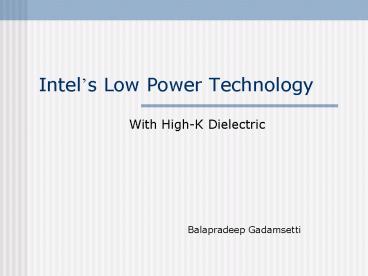Intel - PowerPoint PPT Presentation
Title:
Intel
Description:
Intel s Low Power Technology With High-K Dielectric Balapradeep Gadamsetti Why this is required? Continuation of Moore s Law Transistor scaling with increased ... – PowerPoint PPT presentation
Number of Views:85
Avg rating:3.0/5.0
Title: Intel
1
Intels Low Power Technology
- With High-K Dielectric
Balapradeep Gadamsetti
2
Why this is required?
- Continuation of Moores Law
- Transistor scaling with increased performance and
Reduced Power Consumption
3
Introduction
- Silicon Industry is scaling SiO2 for the past 15
years and still continuing. - SiO2 is running out of atoms for further scaling
but still scaling continues.
4
What is a Transistor ?
- A simple switch
- - current flows from source
- to drain when gate is at certain
- voltage otherwise it doesnt flow
- Gate dielectrics (SiO2) are only a few atomic
layers thick at this thickness even being
insulator current leaks through. - Now Leakage Power became an Issue !!
5
Seeking new materials to drive Moores Law
6
Replacing SiO2 a challenge?
- Materials chosen for replacing SiO2 should be
thicker (to reduce leakage power) but should have
a high-K value.
What is High-K ?
A measure of how much charge a material can
hold. AIR is the reference with
K1. "High-k" materials, such as hafnium
dioxide (HfO2), zirconium dioxide (ZrO2) and
titanium dioxide (TiO2) inherently have a
dielectric constant or "k" above 3.9, the "k" of
silicon dioxide.
7
- Dielectric reduces Leakage power
8
Problems with High-K
- Threshold Voltage Pinning- high-K and Polysilicon
gate are incompatible due to Fermi level pinning
at the High-K and Polysilicon interface which
causes high threshold voltages in transistors - Phonon scattering - High-K/ Polysilicon
transistors exhibit severely degraded channel
mobility due to the coupling of phonon modes in
high-K to the inversion channel charge carriers.
Both the above problems limit the transistor
switching speed !!!
9
High-K and PolySi are Incompatible
10
Mobility degradation in High-k\PolySi
11
Phonon Scatterings
12
Solution- Metal Gates
- Metal gate electrodes are able to decrease phonon
scatterings and reduce the mobility degradation
problem.
Challenges with Metal Gates
Requires metal gate electrodes with CORRECT
work functions on High-K for both nMOS and pMOS
transistors for high performance.
13
Work functions for nMOS and pMOS
14
Breakthroughs with Metal Gates
- N-Type metal and P-Type metal with the CORRECT
work functions on high-K have been engineered. - High-K\metal-gate stack achieves nMOS and pMOS
channel mobility close to SiO2's. - High-K\metal-gate stack shows significantly lower
gate leakage than SiO2.
15
High-Metal-gate reduces leakage
16
pMOS mobility graph
17
nMOS mobility graph
18
Conclusion
- Intel achieved 20 percent improvement in
transistor switching speed - Reduced transistor gate leakage by over 10 fold.
- Integration of more than 400 million transistors
for dual-core processors and more than 800
million for quad-core in Intel 45nm high-k metal
gate silicon technology.
19
References
- http//www.intel.com/technology/silicon/high-k.htm
- http//www.physorg.com/news80.html
- http//www.eetimes.com/conf/iedm/showArticle.jhtml
?articleID18305166kc5012































